City guides


Edinburgh Travel Guide
An historic, atmospheric and arty city, Edinburgh is one of the great European capitals and is deservedly very popular with travellers.
Edinburgh was nicknamed Auld Reekie (Old Smoky) at a time when coal and wood was still relied on to keep the populace warm, and although the city is now a modern metropolis with fabulous shopping and more Michelin-starred restaurants than any UK city bar London, the nickname still suits this delightful and ancient city, with its old chimneys, smoke-stained Gothic buildings and towering, medieval castle. It is easy to understand how Edinburgh has influenced and inspired so many famous authors, as the city feels like something out of a very good novel.
Edinburgh is renowned for its many museums, old buildings and monuments, but it has appeal beyond the historic. The Scottish capital's nightlife is always interesting, with charming old pubs and fashionable nightclubs rubbing shoulders in a number of trendy districts. The city is also celebrated for its performing arts, with many theatres and an exciting and full cultural calendar, the highlight of which is the Edinburgh International Festival in August.
Best time to visit Edinburgh
Edinburgh's weather is notoriously changeable, with plenty of wind and rain in every season. The weather is at its best between May and September, in late spring, summer and early autumn, and this is the most popular time to visit. The city is flooded by travellers during the famous festival in August and the lively Hogmanay New Year's celebrations.
What to see in Edinburgh
-Spend at least a few hours exploring the many wonders of Edinburgh Castle.
-Take a tour of the Palace of Holyrood House, official Scottish residence of the Queen.
-Enjoy thrills, scares and laughs in the Edinburgh Dungeon.
-Explore the Royal Yacht Britannia, used by the British Royal Family for 40 years.
What to do in Edinburgh
-Hike up Arthur's Seat for phenomenal views of Edinburgh.
-Visit the fascinating Rosslyn Chapel, made famous by Dan Brown in The Da Vinci Code.
-Picnic or stroll in the beautiful Royal Botanic Garden.
-Stroll down Edinburgh's Royal Mile, a route crammed with shops, pubs, museums and historic buildings.
Beyond Edinburgh
Many glorious daytrips are possible from the Scottish capital: the cities of St Andrews, Dumfries and Dundee are all within easy reach and bursting with historic attractions, famous golf courses and interesting museums. A trip to Stirling Castle, one of the most impressive fortresses in Scotland, is also a very popular excursion from Edinburgh.
Getting there
Edinburgh International Airport, situated eight miles (13km) west of the city, receives cheap direct flights from many other cities in the UK. Edinburgh is also well connected to cities like London by rail.
Did you know?
-Edinburgh is said to be one of the most haunted places in Europe, with many famous ghost stories and graveyards.
-Grey Friar's Bobby, a terrier, won the hearts of the populace by sitting on his owner's grave for 14 years.
-J.K. Rowling wrote the first Harry Potter novel in the Elephant House cafe, with a view of the castle.
Things to do in Edinburgh
Sightseeing in Edinburgh reveals a score of attractions, highlighting this ancient city's historical, cultural and visual charm. Most Edinburgh attractions are quite centrally located and best enjoyed during the summer, when the days are both longer and warmer. It is easy and pleasant to get around the main tourist enclaves of the city on foot.
Located on the mound of an extinct volcano, Edinburgh Castle includes structures from as early as the 12th century. The National Gallery has displayed fine works of art to the public since 1859 and continues to exhibit an impressive collection. For Scottish opera and ballet performances, visit the Edinburgh Festival Theatre, while the Museum of Edinburgh is another worthwhile attraction.
The Scotch Whisky Experience shows visitors the art of brewing Scotland's celebrated whiskies, locally referred to as 'the water of life'. The Royal Yacht Brittania is docked in the port of Leith and has hosted the likes of Winston Churchill and Nelson Mandela. Founded in 1670, the Royal Botanic Garden is made up of Victorian glasshouses and impressive landscaped grounds. The Royal Mile in Old Town, which stretches from the Castle to the Palace of Holyroodhouse is another must. Strolling down this atmospheric road, travellers will encounter many people advertising themed tours of the city including a number of thrilling historical and ghostly routes, which are a great way to get some insight into this mysterious Gothic city.
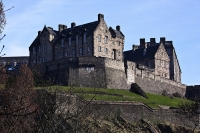
Edinburgh Castle
The imposing castle that stands on the craggy mound of an extinct volcano in the heart of Edinburgh is not only the city's top attraction, but a proud and lasting symbol of the Scottish nation. The castle rock has been inhabited since 800 BC, but today most of the remaining structures date from around the 16th century (with the big exception of St Margaret's Chapel, Edinburgh's oldest building, dating from the early 12th century). Of all the things to see and experience at the Castle, including the spectacular view of the city, the favourite for visitors is the Crown Room, which contains the Scottish crown jewels and regalia of state. Also on view here is the legendary 'Stone of Scone', upon which all the monarchs of Scotland have been crowned.
The castle also still functions as a military headquarters, and is the site of the spectacular military tattoo, which is world-renowned and held each August. At 1pm each day, except Sunday, the 'one o'clock gun' is fired, traditionally to allow ships in the Firth of Forth to check their chronometers. The gun is also fired at New Year to mark midnight during the Hogmanay celebrations. Tickets should be pre-bought online to avoid queuing on arrival, especially if visiting during the summer months.
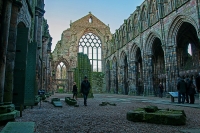
Palace of Holyrood House
The Palace of Holyrood was originally an abbey, built in the 12th century, and later the home of Mary, Queen of Scots, notorious for her turbulent reign and dramatic life. Today the palace is the official Scottish residence of Queen Elizabeth II, and is used by the Royal family for state ceremonies and entertaining, but much of the imposing baroque building is open to visitors. A great audio guide (included in the admission cost) steers visitors around the grand royal apartments, the Throne Room, the Great Gallery, the apartments of Mary Queen of Scots and her husband Lord Darnley and their bed-chambers linked by a secret staircase.
A plaque on the floor marks the spot where Mary's Italian secretary David Rizzio was murdered in 1566. The rooms feature splendid plasterwork ceilings and magnificent furnishings and tapestries. The tour ends with the ruins of the old abbey, still attached to the palace, which are glorious in and of themselves. The gardens can also be enjoyed in the summer months, but are closed in winter. A visit typically takes at least an hour and a half, but those who want to explore thoroughly should allow substantially longer.
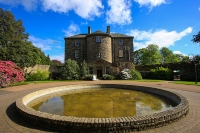
Royal Botanic Garden
Not just any garden, the Edinburgh Botanic Garden is acknowledged as one of the finest in the world. The garden features six percent of all the world's known plants, the most tender being cosseted in elegant Victorian glasshouses. Visitors can admire vegetation from 10 climate zones from tropical palms to arctic tundra, and see some of the world's oldest plants in the orchid and cycad house. There are also several restaurants and cafes, and a gift shop.
The garden was established in 1670 as a physic garden in Holyrood, was later moved to Leith and was firmly planted in Inverleith in 1820, where it has remained a top attraction ever since. It is now one of the top-ranking attractions in Edinburgh according to tourists. Although the garden is at its best and busiest in the summer months, the impressive greenhouses are worth visiting at any time of year, making the botanic garden immune to the seasons to some extent. The views of Edinburgh Castle from the garden are some of the best in the city. The plants are very well labelled, and route maps can be picked up at the visitor centre.
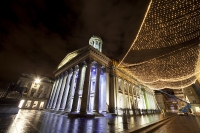
National Gallery of Scotland
The National Gallery of Scotland is situated in the heart of Edinburgh and is home to Scotland's greatest collection of European paintings and sculpture from the Renaissance to Post-Impressionism. The museum opened to the public in 1859 and includes works by Botticelli, Cézanne, Van Dyck, Pisarro, Monet, Raphael, Rembrandt, and Titian. The Gallery also boasts the most comprehensive collection of Scottish painting in the world. Regular temporary exhibitions bring exciting art works to the gallery. Internationally recognised as having one of the best fine arts collections in the world, the National Gallery is a must for art lovers in Edinburgh.
The Scottish Portrait Gallery can be found nearby at 1 Queen Street and includes great paintings of Scots rather than by Scots. The gallery takes visitors through Scottish history by introducing them to the characters that have shaped the country's history and captured the national imagination. Both museums are housed in impressive buildings, but the wall murals in the Portrait Gallery are one of the most striking features of the museum, making it worthwhile to pop into the foyer of the gallery even if you don't have time for a thorough exploration. Both galleries have good cafes on site.
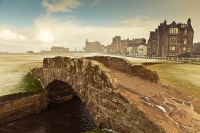
St Andrews
The historic city of St Andrews is home to one of the most famous golf clubs in the world, The Royal and Ancient Golf Club of St Andrews. Often referred to as 'the home of golf', St Andrews and the British Golf Museum will be enjoyable for any enthusiasts of the sport. With 500 years of golfing history, the museum will take visitors on an exciting journey through the sport's heritage and provide an introduction to the world's golfing legends.
Golf aside, St Andrews is an attractive, historic city and is also home to the prestigious University of St Andrews, the oldest university in Scotland and the third oldest in the English-speaking world. Students make up a third of the population during the academic term, giving the old city a youthful energy and fun nightlife. Once the ecclesiastical capital of Scotland, the city's famous and ancient cathedral was destroyed during the Scottish Reformation and now lies in ruins. However, many other historic buildings remain intact and St Andrews prevails to be an atmospheric city with a rich cultural life as well as some of the world's best golfing opportunities.
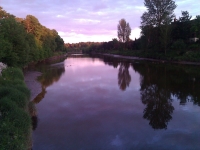
Dumfries
Known as the 'Queen of the South' and birthplace of both world-famous poet Robert Burns and James Barrie, author of Peter Pan, the quaint and picturesque town of Dumfries may not be as large as some of its neighbours, but it is warm, welcoming and beautiful. In 1997 Dumfries was voted the best place to live in the UK, and is still considered by many to be just that, due to its mild climate, lovely setting and the exuberant charm of the locals.
Most of the buildings in Dumfries are built with local red sandstone, which comes from Locharbriggs, giving them a unique character and the city a distinctive look and feel. Around town, visitors with an interest in Dumfries' most famous resident, Robert Burns, can visit no end of sites associated with the poet, including Burns' House, Burns' Museum, Burns Street, Burns' Mausoleum and even his regular corner pub, the old Globe Inn.
Other attractions include the Bridge House Museum, the magnificent triangular Caerlaverock Castle and its nature reserve, New Abbey and the Solway Coast. Scotland's seventh largest river, the River Nith, which runs through the centre of Dumfries, creates a picturesque setting and offers fabulous fishing opportunities right on the town's doorstep. Hit the links and enjoy a round of 18 holes on one of 30 of Scotland's finest golf courses, including Thornhill and Stranraer. Alternatively, put those hand-tied flies to good use when casting for brown trout in the nearby Lochmaben, which has a couple of good fishing lochs; or try for salmon, sea trout and trout from the banks of the River Nith. Just out of town, take a walk along the nearby coastline or high above on the cliff tops where waves crash below and the cool North Atlantic sea breeze invigorates you.
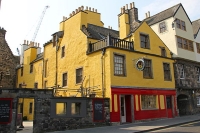
Museum of Edinburgh
Get to grips with the mystery and magic of the ancient city of Edinburgh at the museum dedicated to its history, from prehistoric times to the present day. The Museum of Edinburgh contains important collections relevant to the city's history, from pottery to documents, shop signs to silverware. The building in which the museum is housed is also of interest, dating from the 16th century, it has a chequered history of ownership and tenancy by a variety of people from aristocrats to common workers. There is a gift shop on the ground floor, and although there is no food or drink allowed, there are a number of great pubs and restaurants nearby.
If you enjoy the Museum of Edinburgh, and have a fascination for the history of this old and atmospheric city, another attraction worth visiting is The People's Story Museum. The museum has an emphasis on the personal, exploring the lives of ordinary people in Edinburgh from the late 18th century to the present. The exhibitions immerse visitors in the everyday home and work lives of Edinburgh's population using personal possessions, newspapers and the recreation of a number of rooms and offices to illustrate the changes over the decades. Like the Museum of Edinburgh, the People's Story Museum is free.

Scotch Whisky Experience
Alongside Edinburgh Castle, visitors can enjoy a 'wee dram' and uncover the secrets of brewing Scotland's famed malt, grain and blended whiskies, known to the locals as 'the water of life'. The whisky tour includes a barrel ride through the history of whisky, a tutored tasting, and a chance to meet a resident ghost. The bar offers the chance to choose from about 270 different whiskies, and a restaurant serves up traditional Scottish cuisine.
The interactive tour promises fun for the whole family, although of course only adults are permitted to sample the wares. There are several different tours on offer: The Silver Tour is ideal for families; The Gold Tour offers a more in-depth experience; The Platinum Tour is perfect for the confirmed whisky lover; The Taste of Scotland offers a mixture of whisky tasting and Scottish food; and the Morning Masterclass is crafted for connoisseurs. Although booking is not required it is recommended that visitors book in advance to secure a tour; for the Morning Masterclass pre-booking is essential. The guides are experts in their trade and do a fabulous job of educating visitors and keeping them entertained.
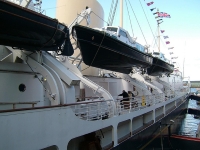
Royal Yacht Britannia
The famed Royal yacht, Britannia, is the pride of the Ocean Terminal in the port of Leith, Edinburgh's recently developed waterfront shopping and leisure area. Numerous illustrious passengers, including Sir Winston Churchill and Nelson Mandela, have trod her decks, not to mention the British Royal Family themselves, who used the ship for 40 years. Now visitors can board this vessel on a self-guided audio tour (available in 22 languages), cruising through the fabulous state apartments, the crew's quarters and the gleaming, polished engine room. Most of the accoutrements on board are original, and there are some surprises too: like the Queen's bedroom and one of her shiny Rolls Royces.
A number of framed photographs of the Royal Family on board the ship make the visit seem all the more intimate. At the Visitor Centre, you can learn about celebrity life on this luxury ship, and browse through the souvenir shop. Having a bite to eat, or at least something to drink in the tearoom is a must. The Royal Yacht Britannia is the top attraction in the country according to VisitScotland, and the tour consistently receives rave reviews from tourists.
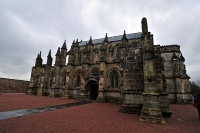
Rosslyn Chapel
Made famous by the conclusion of the exciting novel (later turned movie) The Da Vinci Code by Dan Brown, this 15th-century Gothic church has become a touristic site of pilgrimage, just six miles (10km) south of Edinburgh's city centre. Known among the clergy as the 'Collegiate Chapel of St Matthew', the church was founded in 1446 and features the famous Apprentice Pillar, and remains a working church with regular services on Sundays. Rosslyn Chapel is a beautiful place of worship and features a wealth of sculptures and interesting Gothic features.
Regular introductory talks on the history of the chapel are given by guides throughout the day, which are free of charge and can be attended by anybody who has paid admission. These talks are conducted almost upon the hour from Monday to Saturday, and at 1pm, 2pm and 3pm on Sundays. No photography or video is allowed inside the chapel, but there are no restrictions on photography of the exterior of the building. There is a lovely coffee shop stocked with fresh produce and baked goods from the community in the visitor centre, with great views over the grounds, and a small shop selling souvenirs.
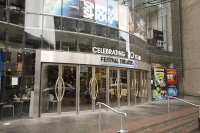
Edinburgh Festival Theatre
The Edinburgh Festival Theatre is used primarily for musical events and touring groups, and it is one of the main venues for the annual summer Edinburgh International Festival, as well as being the year-round venue for the Scottish Opera and the Scottish Ballet. This historic location is Edinburgh's oldest continuous theatre site: there has been a theatre on the site since as far back as 1830. After decades of illustrious but tumultuous performances, in 1963 the theatre became a bingo hall for nearly thirty years, but was still occasionally used as a festival venue.
It re-opened in June 1994 with a glass-fronted structure as the new entrance and a dramatic mix of art nouveau, beaux-arts and neo-classicist architecture, and now has adequate acoustics, serving all the artistic requirements of the community, and seating nearly 2,000 people. There are frequent children's plays and performances at the theatre, making it a good option for families. The Edinburgh Festival Theatre is supposedly one of the city's many haunted buildings, stalked by a tall, dark spectre rumoured to be the famous illusionist Sigmund Neuberger (The Great Lafayette), who was one of a number of performers burnt to death in a stage fire at the theatre in 1911.
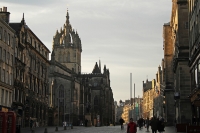
Royal Mile
An essential activity for travellers in Edinburgh is a stroll along the Royal Mile, a succession of streets forming the main thoroughfare of Edinburgh's Old Town. Fittingly, the Royal Mile is approximately one Scottish mile long, running between two historic attractions; Edinburgh Castle at the top of the Castle Rock and Holyrood Abbey. This is Edinburgh Old Town's busiest tourist strip, rivalled only by Princes Street in the New Town. The streets that make up the Royal Mile include Castle Esplanade, Castlehill, Lawnmarket, High Street, Canongate and Abbey Strand.
The Hub, at the top end of the mile, plays host to the Edinburgh International Festival, and holds integral information on all the Edinburgh festivals. Its gothic spire, which is the highest point in central Edinburgh, towers over the adjacent castle and surrounding buildings. During the Festival the Royal Mile comes alive with entertainers and visitors. It would be quite an achievement for any sightseer in Edinburgh to manage to not walk the Royal Mile at some point as the stretch is riddled with many of the city's best and most popular attractions, as well as being the most photogenic amble in Edinburgh. There are many wonderful restaurants, pubs and shops along the Royal Mile, and tourists often choose to find accommodation nearby.
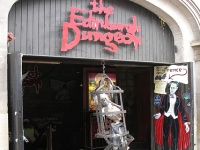
Edinburgh Dungeon
Like the London and York Dungeons, the Edinburgh Dungeon gives a graphic and spine-chilling look into Edinburgh's history. The dungeon employs every trick in the book to scare the life out of its visitors, and it does a pretty good job of it. But behind the scary masks and gruesome make up, it also offers an educational and interesting look at history, which makes it a fun way for children of all ages to learn. The Dungeon is a thrill-filled journey through a thousand years of Scotland's most dramatic and bloody history, and is very funny as well as frightening. The tour takes about 80 minutes and includes 11 live shows and two underground rides as well as incredible sets, disturbing sounds and disgusting smells. Visitors will come face to face with some sinister characters, including serial killers Burke and Hare, cannibal Sawney Bean and Scottish hero William Wallace, among others. Although a huge highlight of a visit to the city for kids, Edinburgh Dungeon is also very popular with adults and nobody will judge you for showing up without children. Booking online not only gets you a discount, it allows you to bypass the often-lengthy queues at the entrance, and is therefore highly recommended.
Edinburgh Zoo
Featuring a wonderful variety of cute and exotic animals, children will be absolutely thrilled with a visit to the Edinburgh Zoo. It also offers younger visitors a Kids Zone where they can do puzzles, meet new additions to the zoo, find out about wildlife in their own back garden and more. A must-see is the penguin parade, held each day at 2.15pm. Another huge attraction of the Edinburgh Zoo is its Giant Panda enclosure, but note that visitors must book a time-slot to see these magnificent animals as they are kept largely out of the public eye. More than a thousand animals are housed in the zoo, in a lovely parkland setting.
For those young visitors keen to meet some marine life as well, Deep Sea World, Scotland's national aquarium, is located just 20 minutes outside the city, and is the perfect place for a fun-filled family outing on a rainy day. Children can view marine life such as sharks, eels and rays from one of the world's longest underwater tunnels, watch seal pups play, and even get to watch a shark-feeding session. There are a series of shallow 'touch pools' for younger tots to touch and handle some of the sea life, such as starfish and sea urchins.
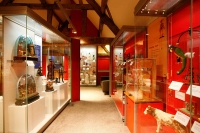
The Museum of Childhood
When travelling to Edinburgh with children, a trip to the Museum of Childhood is an absolute must and a favourite with both adults and children. It contains wonderful displays, featuring toys from the past and present from all around the world, as well as displays about other aspects of childhood, including school, sports, health and holidays. The toys fill five floors and all the classics are here, including model railways, hundreds of dolls and exquisite doll houses. There are also more original and unexpected toys, including ones made at home when money was too short to buy.
While children enjoy playing with the toys, adults will enjoy the feelings of nostalgia at seeing their favourite childhood playthings. Many of the antique toys are kept safely behind glass, but there are some fun interactive exhibits including a puppet theatre, Lego, books and a dress-up section. There is also a delightful museum shop filled with toys, books and games. There is no restaurant or cafe in the museum, but there are many lovely places to eat nearby as the Museum of Childhood is on the Royal Mile.
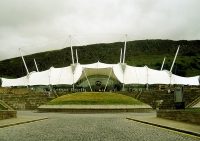
Our Dynamic Earth
Situated at the foot of Edinburgh's beautiful Salisbury Crags, this science centre is a fabulous attraction for children of all ages and adults alike, and aims to educate and inspire visitors to think about our planet and its evolution. Our Dynamic Earth takes visitors on a journey through planetary events like the Big Bang, the history of Earth with dinosaurs and prehistoric landscapes, fascinating natural phenomena like the magical Aurora Borealis and volcanic eruptions, and current important issues like climate change and population growth.
Featuring a number of changing exhibitions, there's always guaranteed to be something new to discover upon each visit to Our Dynamic Earth. Most of the attractions are interactive and many are positively thrilling as well as educational. Take a spin in the G-Force space ball, and explore the many wonders of the world in which we live. Our Dynamic Earth will delight adults as well as children, and is a wonderful Edinburgh attraction for a rainy day.
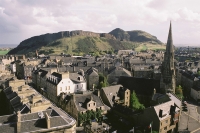
Arthur's Seat
The tallest of the seven hills that form Holyrood Park at 822 feet (250m), Arthur's Seat is actually an extinct volcano that overlooks the city of Edinburgh. There are the remains of an Iron Age hill fort, with several grassy plateaus that make for pleasant stopping points on the way up. Described by poet Robert Louis Stevenson as 'a hill for magnitude, a mountain in virtue of its bold design', Arthur's Seat is popular for hikes, and the view from the top over Edinburgh and the surrounding countryside is well worth the climb.
There are many different walking trails and the hill can be climbed from almost any direction, though the easiest and most popular route is from the east. The climb is not difficult but does get steep at the end so sensible shoes are recommended. Those who are less fit can drive half way up the hill before beginning their walk. There are many ideas for how the hill got its name, among them the famous legend of King Arthur and his half-sister Morgan Le Fay; the hill is sometimes suggested as a possible site for Camelot, but the suggestion is seldom taken seriously. Traditionally, the young women of Edinburgh wash their faces in the dew on the slopes of Arthur's Seat every May Day to make themselves more beautiful.
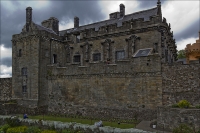
Stirling Castle
One of the most impressive castles in Scotland, Stirling Castle has a famous history of clashes between British troops and Scottish revolutionaries. Its bridge is the site of one of William Wallace's major victories, and the field of Bannockburn was the venue for the triumph of Robert the Bruce. Stirling Castle was also home to generations of Scottish monarchs, including Mary Queen of Scots. The views of the surrounding countryside, including the famous Wallace Monument, are spectacular.
Free guided tours run throughout the day and there is an excellent audio guide available in English, French, German, Italian, Spanish and Japanese for a small extra cost. The fascinating history of the castle makes it worthwhile to hire an audio guide, or at least do some research beforehand, as past events bring the sprawling castle and surrounding area magnificently to life. Even without the audio guide, there are exhibitions and displays offering some information about the castle and the important battles fought there. Although some of the castle is in ruin, other areas have been carefully restored to give visitors a sense of how it must have looked during its glory days.
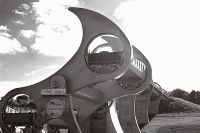
Falkirk Wheel
The Falkirk Wheel, a rotating boat-lift located near the town of Falkirk in central Scotland, is an unlikely but extremely popular Scottish tourist attraction. The Wheel, which was built as part of an initiative to rejuvenate Scotland's canals and waterways, is a tremendous feat of engineering. Visually spectacular, the Falkirk Wheel has an overall diameter of 115 feet (35m), and features two 45-foot (15m) mechanical arms, shaped like double-headed Celtic axes. A landmark in Scottish engineering, the Falkirk Wheel features on the obverse of the country's £50 note.
An increasingly popular day excursion from Edinburgh, visitors to the Falkirk Wheel can enjoy 50-minute boat rides on the Union Canal that feature an exciting 'lift' on the Falkirk Wheel. Kids will also love the Waterwalkerz Activity Zone found at the site, and the whole family can enjoy the four miles (7km) of woodland walking trails that surround the area. Bicycles can also be hired. The Falkirk Wheel hosts some special events, including some deals for Christmas and similar occasions. A fun and educational day out with the kids, a trip to the Falkirk Wheel is highly recommended for family vacationers in Scotland.
Things to do with kids in Edinburgh
The historic city of Edinburgh is brimming with old castles and fascinating sights that can be enjoyed by adults and children alike. Kids love Edinburgh's spooky aspects; the castle alone could fill a whole day with excitement.
An outing to the Royal Yacht Brittania or a visit to the many animals at the Edinburgh Zoo can be appreciated by the whole family. A picnic and Frisbee session in the beautiful Royal Botanic Garden for some fresh air and sunshine is another lovely way to spend a day. For an educational excursion, visit the Museum of Edinburgh to soak up the history of this famous city, or venture to Our Dynamic Earth which will astound the little ones and get them thinking about their place in the grand scheme of things.
When skies are grey and outdoor attractions are not an option, take the kids to discover some aquatic animals at the Deep Sea World Aquarium, or make use of indoor playgrounds such as the one in Edinburgh Park, Happy Castle Play Centre or Time Twisters. Another real highlight for kids (and often their parents too) is the Edinburgh Dungeon.

Edinburgh Dungeon
Like the London and York Dungeons, the Edinburgh Dungeon gives a graphic and spine-chilling look into Edinburgh's history. The dungeon employs every trick in the book to scare the life out of its visitors, and it does a pretty good job of it. But behind the scary masks and gruesome make up, it also offers an educational and interesting look at history, which makes it a fun way for children of all ages to learn. The Dungeon is a thrill-filled journey through a thousand years of Scotland's most dramatic and bloody history, and is very funny as well as frightening. The tour takes about 80 minutes and includes 11 live shows and two underground rides as well as incredible sets, disturbing sounds and disgusting smells. Visitors will come face to face with some sinister characters, including serial killers Burke and Hare, cannibal Sawney Bean and Scottish hero William Wallace, among others. Although a huge highlight of a visit to the city for kids, Edinburgh Dungeon is also very popular with adults and nobody will judge you for showing up without children. Booking online not only gets you a discount, it allows you to bypass the often-lengthy queues at the entrance, and is therefore highly recommended.
Edinburgh Zoo
Featuring a wonderful variety of cute and exotic animals, children will be absolutely thrilled with a visit to the Edinburgh Zoo. It also offers younger visitors a Kids Zone where they can do puzzles, meet new additions to the zoo, find out about wildlife in their own back garden and more. A must-see is the penguin parade, held each day at 2.15pm. Another huge attraction of the Edinburgh Zoo is its Giant Panda enclosure, but note that visitors must book a time-slot to see these magnificent animals as they are kept largely out of the public eye. More than a thousand animals are housed in the zoo, in a lovely parkland setting.
For those young visitors keen to meet some marine life as well, Deep Sea World, Scotland's national aquarium, is located just 20 minutes outside the city, and is the perfect place for a fun-filled family outing on a rainy day. Children can view marine life such as sharks, eels and rays from one of the world's longest underwater tunnels, watch seal pups play, and even get to watch a shark-feeding session. There are a series of shallow 'touch pools' for younger tots to touch and handle some of the sea life, such as starfish and sea urchins.

The Museum of Childhood
When travelling to Edinburgh with children, a trip to the Museum of Childhood is an absolute must and a favourite with both adults and children. It contains wonderful displays, featuring toys from the past and present from all around the world, as well as displays about other aspects of childhood, including school, sports, health and holidays. The toys fill five floors and all the classics are here, including model railways, hundreds of dolls and exquisite doll houses. There are also more original and unexpected toys, including ones made at home when money was too short to buy.
While children enjoy playing with the toys, adults will enjoy the feelings of nostalgia at seeing their favourite childhood playthings. Many of the antique toys are kept safely behind glass, but there are some fun interactive exhibits including a puppet theatre, Lego, books and a dress-up section. There is also a delightful museum shop filled with toys, books and games. There is no restaurant or cafe in the museum, but there are many lovely places to eat nearby as the Museum of Childhood is on the Royal Mile.

Our Dynamic Earth
Situated at the foot of Edinburgh's beautiful Salisbury Crags, this science centre is a fabulous attraction for children of all ages and adults alike, and aims to educate and inspire visitors to think about our planet and its evolution. Our Dynamic Earth takes visitors on a journey through planetary events like the Big Bang, the history of Earth with dinosaurs and prehistoric landscapes, fascinating natural phenomena like the magical Aurora Borealis and volcanic eruptions, and current important issues like climate change and population growth.
Featuring a number of changing exhibitions, there's always guaranteed to be something new to discover upon each visit to Our Dynamic Earth. Most of the attractions are interactive and many are positively thrilling as well as educational. Take a spin in the G-Force space ball, and explore the many wonders of the world in which we live. Our Dynamic Earth will delight adults as well as children, and is a wonderful Edinburgh attraction for a rainy day.
Eating Out
With a thriving food scene, there is no reason to go hungry when visiting Edinburgh. With restaurants to suit all tastes and pockets, hungry travellers need not survive only on traditional Scottish fare such as Haggis, salmon and Aberdeen Angus beef, despite being widely enjoyed. A broad range of international cuisine is readily available in Edinburgh, along with numerous modern cafes, bistros and gastropubs feeding the city's growing gourmand culture. Quality seafood is also a highlight, sourced locally and served deliciously fresh.
There are a number of Michelin-starred restaurants with famous chefs in Edinburgh; in fact, the city is second only to London for Michelin-starred restaurants in the UK. These renowned establishments include The Kitchin, 21212, Castle Terrace and Number One in Balmoral hotel.
When eating out in Edinburgh, the best local cuisine, including good old fish and chips, can be found in and around the Royal Mile or the historic port of Leith. For French, Italian and Indian cuisine, diners should try the area around the castle, Ocean Drive (also in Leith), George Street and Lothian Road. Those on a budget will find many familiar international fast food chains in the city. Edinburgh has many popular restaurants serving tasty vegetarian and vegan fare.
Most restaurants are open daily and reservations are recommended. A 10 percent tip is customarily given to the waiter if the service is good.
Shopping
Shopping in Edinburgh provides something for everyone; from high-end boutiques and luxury brands to vintage treasure troves and unique speciality stores, it's easy to come away with a quality buy.
Princes Street, the main street of the New Town of Edinburgh, is by far the most well-known and popular strip to do a spot of shopping. Here most people manoeuvre their way through the bustling crowds to get to some of the major UK chain stores, as well as a few independent shops. The slightly calmer and more exclusive George Street runs parallel to Princes Street but is somewhat pricier. At the east end of the street, Princes Mall contains plenty of specialist shops and boutiques.
The Royal Mile, which forms the spine of the atmospheric Old Town, is a slightly more off-beat shopping destination with loads of quirky independent stores. Popular buys in Edinburgh include tartan scarves and kilts, whisky, Edinburgh Crystal and tweeds. The many shops along this stretch clearly cater primarily to tourists, with plenty of souvenirs on offer. The Stockbridge Sunday Market is also worth a visit to browse the stalls selling fresh local produce and handcrafted wares including jewellery, ceramics and soap.
Shops in Edinburgh are generally open Monday to Friday from 9am to 5.30pm, with late-night shopping on Thursday until roughly 8pm. Some larger stores open on Sundays. Many shops (especially those frequented by tourists) are part of the Tax-Free scheme and shoppers are advised to keep their receipts and fill out a claim form to have the 17.5 percent VAT refunded.
Nightlife
Edinburgh's nightlife comes alive during its many festivals, but outside of these energetic periods a more subdued, trendy bar, pub and nightclub scene can be enjoyed by visitors. There is no central nightlife district in Edinburgh and instead a few different neighbourhoods offer slightly different atmospheres after dark.
Despite the Old Town's name, the district has new and trendy areas such as Cowgate and Grassmarket. Both of these are popular bar-hopping destinations. Great live bands and folk music is best heard in both these areas and the surrounding small alleys and walkways. The Royal Mile is also home to a few atmospheric traditional pubs.
The seafront area of Leith has a contemporary feel, but like many areas in Edinburgh, the trendy bars and clubs compete with charming old pubs. After-work watering holes dot the Edinburgh streets of most neighbourhoods as they have done for centuries. These popular local haunts are a great place to begin an evening or end a day.
Edinburgh enjoys a relaxed nightlife atmosphere, which is complemented by lax rules and drinking hours. Most bars stay open until one to three in the morning, and much later for festivals. The city parties hard during the Edinburgh Festival and the New Year's celebrations of Hogmanay.
Getting Around
A good network of bus routes covers the city and this is the main form of public transport. Buses are given exclusive use of certain lanes within the city, and as a result the services are fairly free-flowing. Exact change is required as one enters the bus, so buying a One-Ticket pass is a convenient option: this allows unlimited travel in and around the city by bus. Night buses come into operation after midnight, offering an economical way to get home after a night out. Black taxis are easily hailed in the street and there are numerous taxi ranks, but rates are a bit expensive. Rental cars can be useful for touring the country, but driving around Edinburgh's one-way, narrow streets can be confusing, and parking is difficult to find. The city is definitely best explored on foot for those who can handle the steep roads; in fact, any other mode of transport will deprive visitors of some glorious sights.
Edinburgh Climate and Weather
Edinburgh has a temperate, maritime climate which is relatively mild considering the city's northern latitude, but may still frustrate tourists with plenty of cold, rain, wind and fog year round. Edinburgh, like the rest of the UK, has very unpredictable weather, with sunny summer days sometimes rapidly changing into damp, showery bleakness or vice versa. Summers are generally fine though, with mild temperatures and bright sunshine, although days might start out misty. Winters are long and damp with many frosty days. The winter months of December, January and February are the rainiest (although rain is likely in any season) but snow is infrequent. The average temperatures in summer, between June and August, range between 49°F (9°C) and 66°F (19°C). The average temperatures in winter, between December and February, range between 34°F (1°C) and 45°F (7°C). The best time to travel to Edinburgh is during spring and summer, between April and August.
United Kingdom travel info
Electricity
The electrical current in the UK is 240 volts, 50Hz. Flat, three-pin plugs are standard.
Language
English is the official language, though visitors will be astonished by the variety of regional accents.
Money
The currency is the British pound (GBP), which is divided into 100 pence. ATMs are available in almost all towns and Visa, MasterCard and American Express are widely accepted. Foreign currency can be exchanged at bureaux de change and large hotels, though better exchange rates are likely to be found at banks.
Tipping
Tips of 10 to 15 percent are expected in restaurants and upmarket hotels in the UK if a service charge hasn't been included. Hotel service staff receive an optional amount, while taxi drivers are usually given 10 to 15 percent of the fare. Tipping bartenders isn't expected, and tipping for other services is discretionary.
Health
There are no specific health risks associated with travel to the UK and food and water can be considered safe. The British National Health Service is excellent, and a number of countries have reciprocal health agreements with the UK including Australia, New Zealand and EU countries. Visitors from other countries such as Canada, South Africa and the United States are advised to take out comprehensive travel insurance.
Safety
It's generally safe to travel throughout the UK.
Local customs
Handshaking is customary when introduced to someone new. Smoking is banned in all enclosed public spaces, including pubs, restaurants and public transport. Queue barging is frowned upon and there is strict etiquette on escalators: stand on the right, walk on the left. Visitors may find Londoners more rushed and less friendly than locals in other parts of the country, particularly on London transport, where tourists are often the only people who talk.
Doing business
The four countries of the United Kingdom, although culturally and historically different, generally keep to the same business practices. Politeness and punctuality are key to good business relations and initial meetings are often conducted formally and impersonally, becoming more open and social as things progress. Business cards are exchanged at introductions, and dress is formal with dark suits preferred. Business hours are generally 8am to 5pm Monday to Friday with an hour taken at lunch.
The communication style can be difficult to adjust to: the British people respect politeness to a point that often obscures their ability to say exactly what they mean. As a result, travelling business people may need to learn to 'read between the lines' and to take cues from tone of voice and facial expression. Humour is also an integral part of the British system of communication, and is used to diffuse a tense situation and to cultivate relationships. Foreigners should never assume that an attempt at humour undermines a person's ability to do their job, or discredits the importance they attach to a deal or negotiation. Furthermore, they shouldn't be fooled into thinking that the British propensity for irony and sarcasm equates with an informal work environment.
Foreigners should be tactful during meetings, avoid becoming emotional and illustrate their experience with the subject at hand. Performance and initiative are looked upon favourably, whereas academic pretension is given far less credence. Meetings are often used as platforms for debate, rather than moments of confirmation, so there should be no surprise if not much progress is made. Foreigners should be sure to respect and appeal to all parties involved, as the British have recently begun to take a far flatter approach to management and the responsibility of decision-making. And if things go well, it's worth purchasing a pint or two for clients or colleagues; though gifts are borderline inappropriate, a round of drinks will rarely be refused.
Duty free
Travellers can bring the following goods into the UK tax or duty free: 200 cigarettes, 100 cigarillos, 50 cigars or 250g of tobacco, 18 litres of still table wine, 42 litres of beer, 4 litres of spirits or strong liqueurs or 9 litres of fortified wine, sparkling wine or other alcoholic beverages of less than 22 per cent volume.
Communications
The international country dialling code for the UK is +44. Mobile phone coverage is extensive and free WiFi is widely available in pubs and coffee shops. Travellers can purchase local prepaid SIM cards for unlocked phones or use eSIMs if their cellular providers support it on their networks.
Passport & Visa
If a visa is not required, travellers should hold a return or onward ticket, and proof of funds for the duration of stay. Passports must be valid for the period of intended stay in the UK. It's highly recommended that travellers' passports have at least six months' validity remaining after the intended date of departure from their travel destination. Immigration officials often apply different rules to those stated by travel agents and official sources. For visitors who are visa exempt up to a maximum stay of six months, the period of stay will be determined by the Immigration Officer on arrival.
Entry requirements
US travellers must hold a passport that is valid for the duration of their stay; a visa is not required for stays of up to six months.
Canadian passports must be valid for at least the expected duration of the stay. No visa is required for stays of six months or less.
Australian passports must be valid for at least six months after the departure date. No visa is required for stays of six months or less.
South Africans require a valid passport and a visa for entry or transit through the UK. South African temporary passports are not recognised.
Under the Common Travel Area agreement, citizens from the UK and Ireland are not required to pass through passport control. They can travel between both countries without a valid passport if they can prove they are a valid UK or Irish national.
New Zealand nationals must hold a valid passport, but no visa is required for stays of up to six months.
Useful contacts
United Kingdom Tourism Website: www.visitbritain.com
999 (General)Embassies / consulates in other countries
British Embassy, Washington DC, United States: +1 202 588 6500.
British High Commission, Ottawa, Canada: +1 613 237 1530.
British High Commission, Canberra, Australia: +61 2 6270 6666.
British High Commission, Pretoria, South Africa: +27 12 421 7500.
British Embassy, Dublin, Ireland: +353 1 205 3700.
British High Commission, Wellington, New Zealand: +64 4 924 2888.
Embassies / consulates in United Kingdom
United States Embassy, London: +44 20 7499 9000.
Canadian High Commission, London: +44 20 7004 6000.
Australian High Commission, London: +44 20 7379 4334.
South African High Commission, London: +44 20 7451 7299.
Irish Embassy, London: +44 20 7235 2171.
New Zealand High Commission, London: +44 20 7930 8422.


